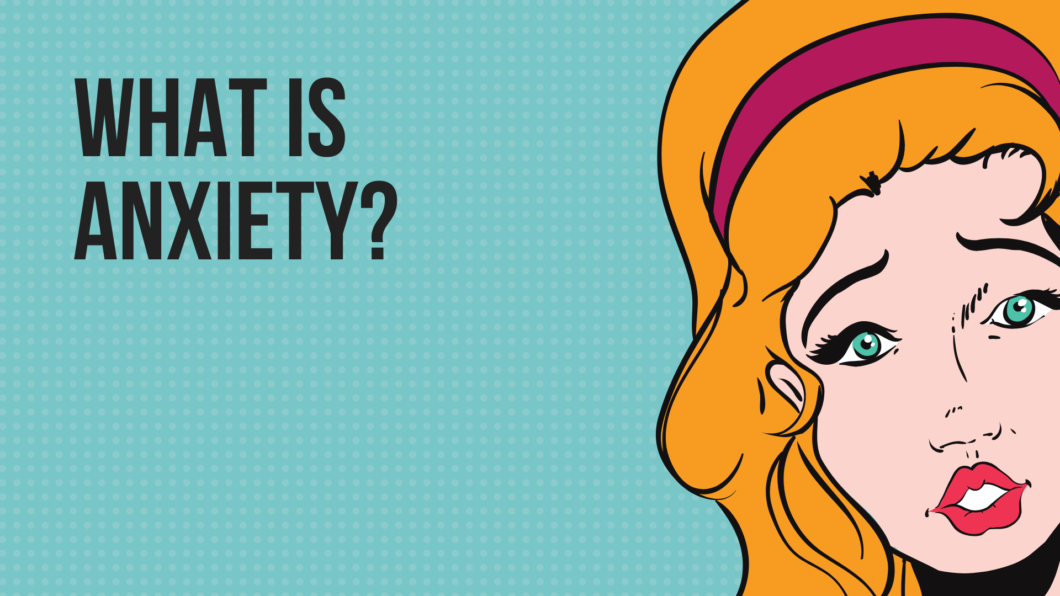Author: Olga Goralewicz, ACT Specialist
Anxiety is an unpleasant emotion that causes a state of internal turmoil, tension, and nervousness. It is completely normal, and we all experience it under certain circumstances.
On the other hand, an anxiety disorder is characterized by this state being persistent and long-lasting. A struggle appears when the patient is lacking coping skills. It is recommended that if it interferes excessively with one’s personal or professional life, the patient should seek treatment.
David Barlow, an expert in anxiety, quotes that it is:
“a future-oriented mood state in which one is not ready or prepared to attempt to cope with upcoming negative events”.
Do I have anxiety or an anxiety disorder?
Anxiety becomes a mental health issue when the signs and symptoms begin to interfere with daily activities.
Have a look at the following triggers:
- The first day of school
- A job interview
- Giving a speech
- Moving countries
- Taking an exam
Feeling anxiety as a result of such situations is completely normal and may even help us prepare. It is normal to be stressed or nervous when such events arise.
Even avoiding such events can still allow you to live a fulfilling life without endangering mental health. Such situations are relatively rare, unless you go out of your way to seek them.
| Did you know? |
|---|
If you have a specific fear of, let’s say, performing, but a life on stage is something you desire, Acceptance and Commitment Therapy might be a great suit for you. Learn how your values can motivate you to overcome specific fears. |
It may, however, be a cause for concern if things like:
- entering an elevator,
- checking out at the grocery store,
- validating your parking ticket, or
- crossing the street
make you feel anxious, especially if it happens often. This is because anxiety is a protective mechanism that shouldn’t occur when there is no reasonable risk of danger. Fearing everyday events such as the ones listed above may lead to significant disturbance of your life.
When you should seek help
Report to a professional if you notice any of the following:
- you have stopped doing many things you enjoy
- you are unable to be productive
- you feel unhealthy coping mechanisms such as substance abuse are becoming a problem
- you have suicidal thoughts or behaviors
Anxiety symptoms
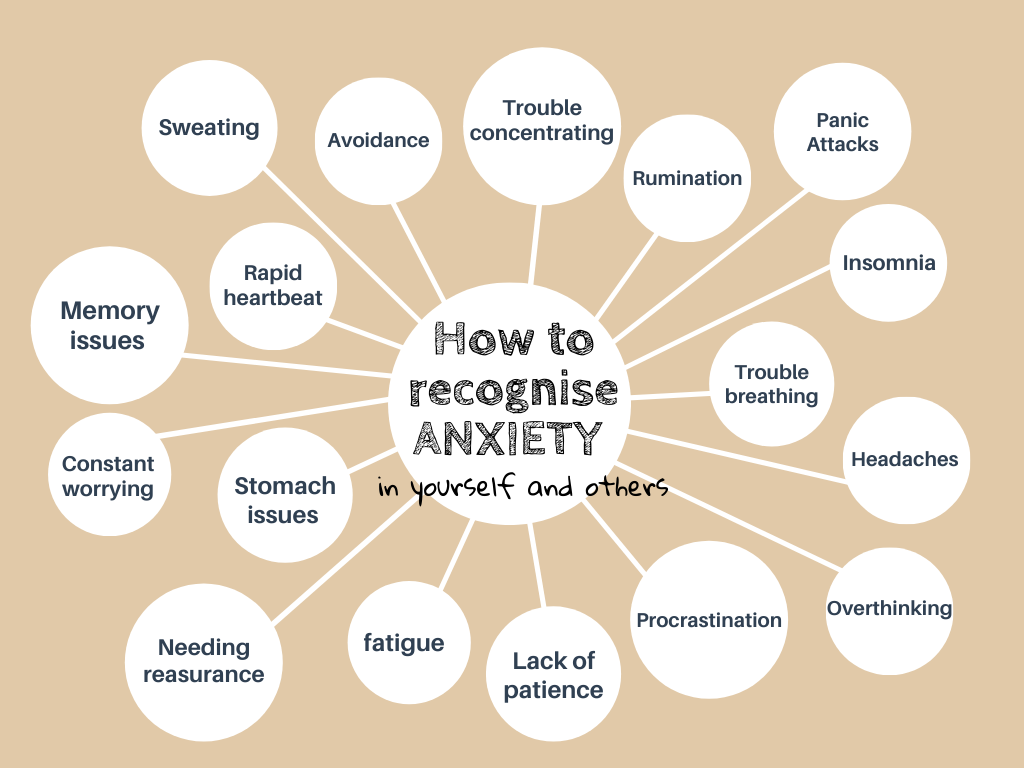
Anxiety can be a reaction to stress, but it may also occur without any obvious triggers. The most prominent sensation is a lack of control over what is going to happen.
People suffering from an anxiety disorder may be constantly stuck in a cycle of feeling anxious about their anxiety.
Everyone is different. You may experience some or all of the symptoms listed below. You may also find that you have your own ones.
Download an anxiety signs and symptoms checklist. You may find it helpful to fill out this form and bring it with you to a specialist.
- problems in concentration
- rumination
- irritability
- feeling like your mind has gone blank
- memory trouble
- feeling helpless
- constant thoughts of death
- constantly anticipating the worst
- fatigue
- restlessness
- trouble with sleeping
- muscle tension
- fight-or-flight response
- changes in eating habits
- elevated heart rate
- increased blood pressure
- shortness of breath
- heart palpitations
- shakiness
- headaches
- nausea
- diarrhea
- dry mouth
- chest pain
- impotence
- avoiding situations that provoked anxiety in the past
- pacing back and forth
- foot-tapping
- nervous tics
- nail biting
- self-soothing (e.g. thumb-sucking or hugging yourself)
- unintentional speaking in a high-pitched voice
- Anxiety disorder diagnosis
In order to diagnose somebody with anxiety, symptoms have to be present for at least 6 months. There isn’t a single test that can determine that someone suffers from this kind of disorder.
Doctors often conduct physical and mental health examinations as well as psychological questionnaires. The ICD-10 code for anxiety is F41.9 and medication, if prescribed, is billable.
A physical exam may include blood and urine tests to preclude other underlying medical conditions. Patients may exhibit anxiety symptoms while the cause is rooted in:
- respiratory conditions eg. asthma,
- substance abuse or withdrawal,
- sexual dysfunctions,
- heart disease,
- or something else.
Once these issues are targeted, anxiety symptoms often decline. But what if there is no underlying physical problem?
What causes anxiety disorders?
An anxiety disorder is usually caused by a combination of environmental and genetic factors as well as brain chemistry.
Mental health examinations and psychological questionnaires check for:
- a lack of coping skills,
- family history of mental disorders,
- trauma or PTSD,
- early life experiences such as bullying or parental neglect, and
- stress factors in everyday life.
All of those can contribute to the development of an anxiety disorder.
Types of anxiety disorders
Symptoms, causes, and triggers can be categorized into many different groups. The American Psychiatric Association reports that people often suffer from several types of anxiety disorders at the same time.
The following are the most common.
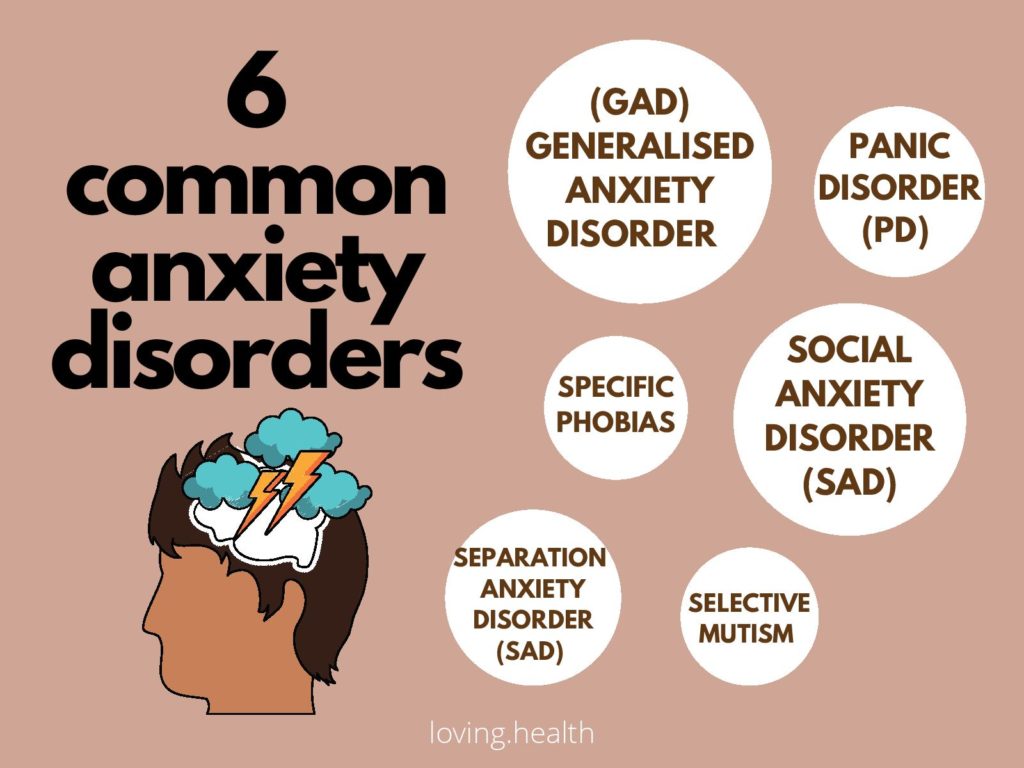
Generalized anxiety disorder (GAD)
Generalized Anxiety Disorder is usually not caused or triggered by any specific object or situation. Patients are often stressed and worried about everyday matters. They have problems making decisions and remembering commitments and responsibilities.
GAD affects about 6.8 million adults in the US. Only about 43.2% are currently undergoing treatment.
Social anxiety disorder
A social anxiety disorder is a fear of judgement and rejection by others. Patients experience a strong fear of interacting with people and, to put simply, “making a fool of themselves” in any social situation.
Those with social anxiety have a strong tendency to avoid any situations involving a social context, some are unable to leave the house altogether. There is a strong reaction to embarrassment or humiliation that is often followed by physical symptoms.
Social anxiety may be focused around specific situations such as public speaking but may be more general. In the latter case, patients may only have a small circle of friends or relatives they are comfortable interacting with.
Severe cases of social anxiety disorder are linked with complete social isolation, depression, and other mental health issues.
It is estimated that almost 7% of US adults are affected by social anxiety disorder.
Separation anxiety disorder
Separation anxiety disorder involves extreme levels of stress as a reaction to being separated from a person or place. Even a very short period of separation may cause a patient to feel overwhelmed or even panic.
Separation anxiety is most common in children. It is often developed due to poor parental behavior. Many parents understand separation anxiety as a form of affection and neglect to have it professionally diagnosed and treated.
Specific phobias
This is the largest category of anxiety disorders. Triggers are very specific in this case. It is usually a particular object, situation, or activity. This stimulus brings on an excessive amount of stress every time and avoidance is very visible.
Patients tend to over-exaggerate terrifying consequences of encountering the object of their phobia. Common triggers include spiders, heights, blood, and tunnels. Patients almost always acknowledge that their fear is not rational or proportional to the threat. Nonetheless, they are unable to get over the feeling.
Panic disorder
The American Psychological Association describes a panic disorder as a condition that includes frequent but brief episodes of intense terror. Such an attack feels a lot like the “fight-or-flight” response and lasts no more than a few minutes.
Triggers are often unspecified and episodes arise without any warning or pattern. An important aspect of a panic disorder is being terrified of the next episode and feeling like it may occur at any moment.
The Cleveland Clinic reports that panic disorder affects 2-3% of the US population and usually begins during adolescence.
Selective mutism
Selective mutism pertains to patients who are physically able to speak but become mute in specific situations. It often co-occurs with shyness and social anxiety.
Patients with selective mutism will remain silent, even if the consequences bring embarrassment, punishment, or even further anxiety and stress.
Diagnosing selective mutism should take place as soon as possible. Doctors must determine whether a child’s behavior is mental or linked to physical issues with the tongue, larynx, or hearing.
Neglecting to pinpoint whether the issue relates to physical or mental health is key to a child’s proper development of speaking and listening skills.
Panic attack vs. anxiety attack
The main difference between an anxiety attack and a panic attack is the time it lasts and how long it takes to build up.
A panic attack appears suddenly and without a specific trigger. It lasts for a few minutes and is incredibly intense, often rendering the patient unable to undertake any action.
An anxiety attack may build up slowly over time, even a few days or weeks, and may worsen as the triggering situation approaches.
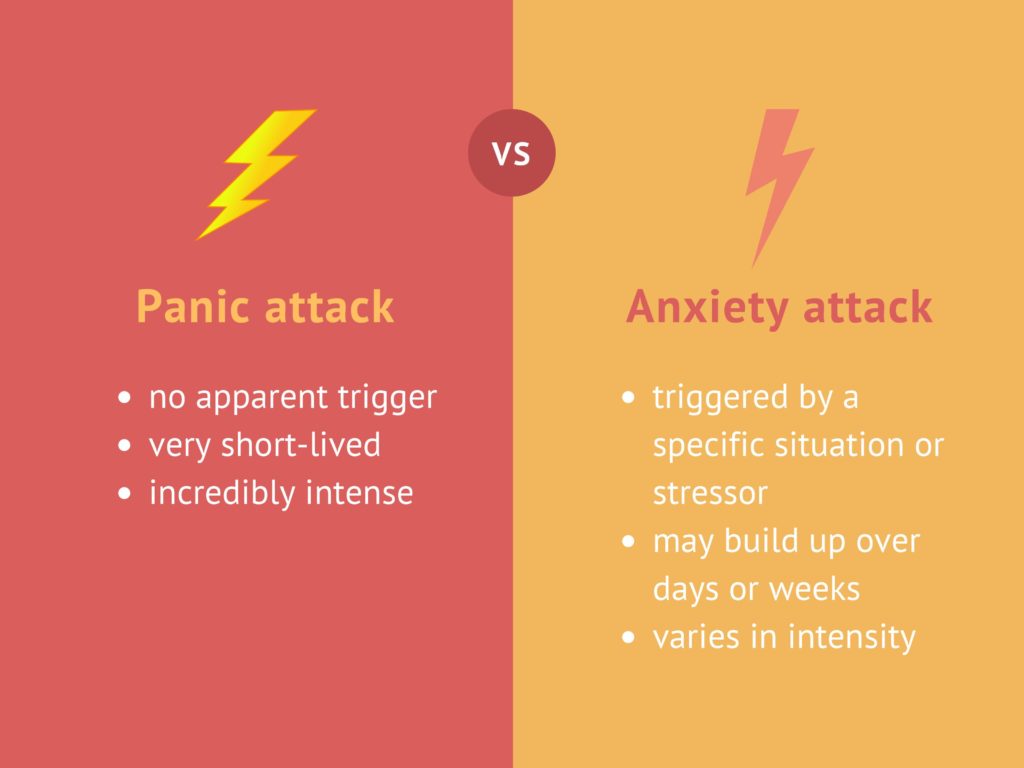
Many patients want to know the answer to a simple question: How to calm anxiety? Unfortunately, there is no quick fix. Learning to control your body’s reaction to anxiety triggers is more like a journey than a recipe.
Treatment may include therapy, medication, and lifestyle changes, or a combination of those. If the cause of anxiety is brain chemistry or hormonal imbalance, medication is often prescribed.
Anxiety medication, however, is not necessarily the best way for everyone. Some patients, for example, those who have suffered from substance abuse, may be unfit for such treatment.
What type of anxiety therapy is most effective?
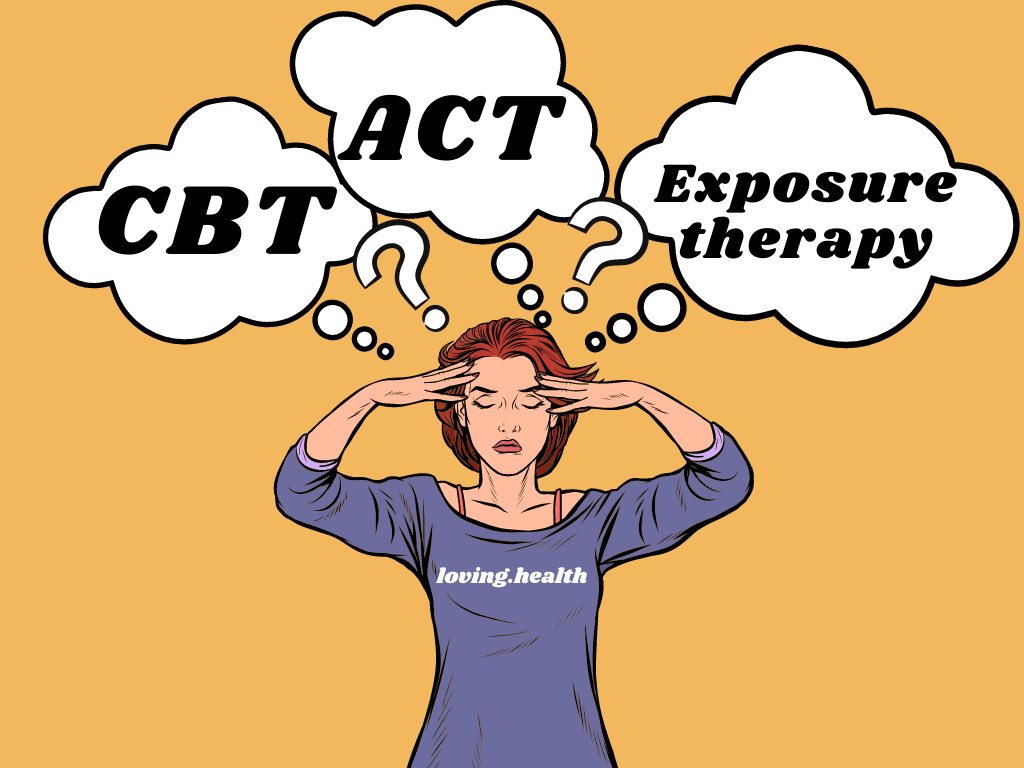
The most common type of therapy for anxiety disorders is Cognitive Behavior Therapy (CBT) and it is usually the first step. It can be carried out face-to-face or over the internet and may be combined with anxiety medications.
CBT is focused on interfering with thought patterns and behaviors that cause mental health problems. The root problems are broken down to understand why they are destructive. Rather than focusing on the past, CBT is geared towards resolving current issues.
Exposure Therapy for anxiety is a form of CBT and it involves a gradual introduction of triggers into daily life. The premise is that patients become less sensitive to stimuli with each encounter. This technique can take a long time and may not be effective when administered as self-help.
In the understanding of Acceptance and Commitment Therapy, anxiety is termed Experiential Avoidance Disorder. That is because ACT presupposes that the biggest issue with anxiety is avoiding situations that trigger unpleasant thoughts and feelings at the cost of a fulfilled life.
Instead of finding ways to calm down and change reactions, patients are taught to accept that unpleasant sensations come and go. The goal is to stop struggling and distracting yourself, and instead learn to experience all that life has to offer.
Best therapy for anxiety | ||
|---|---|---|
| Acceptance and Commitment Therapy (ACT) | Cognitive behavioral therapy (CBT) | Exposure Therapy (ET) |
|
|
|
Learn how to help yourself with ACT for anxiety disorders.
If you would like to know more, schedule an Acceptance and Commitment Therapy session with a Olga

